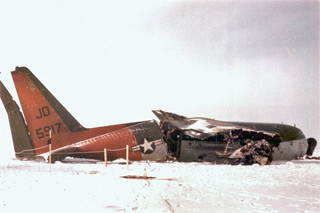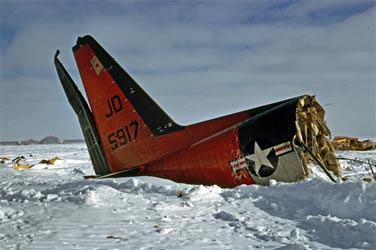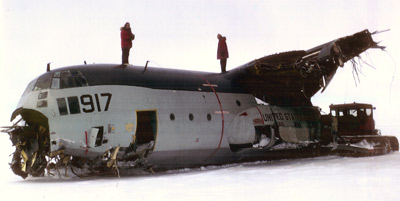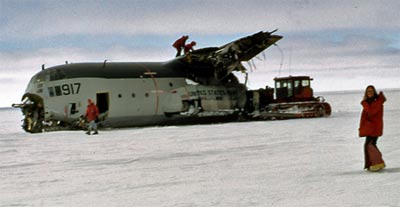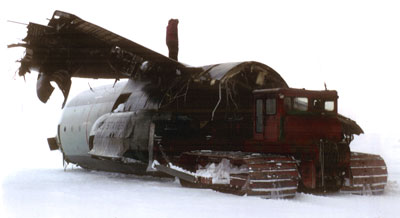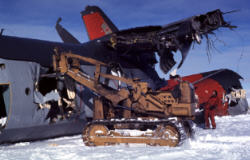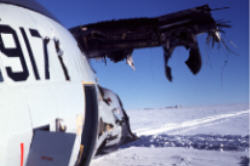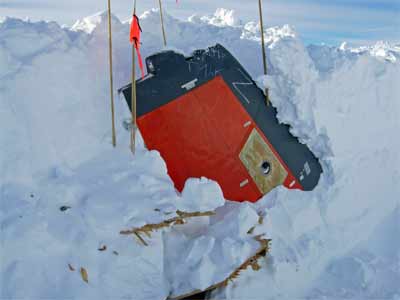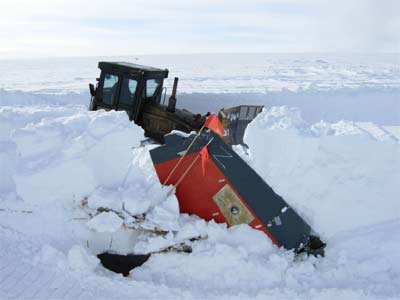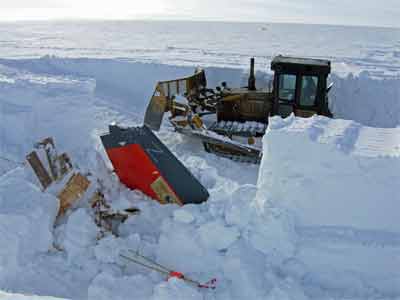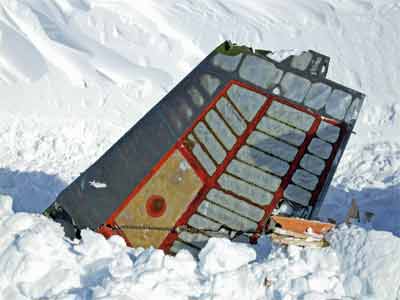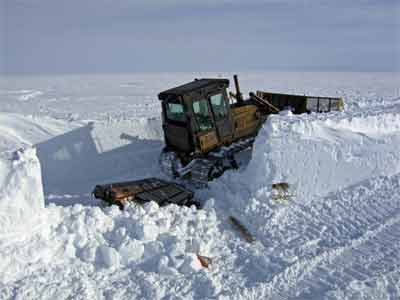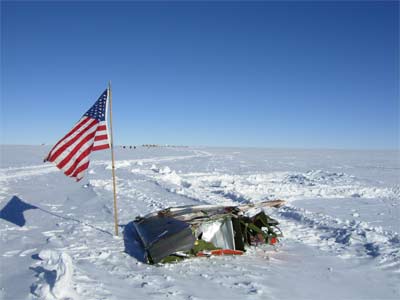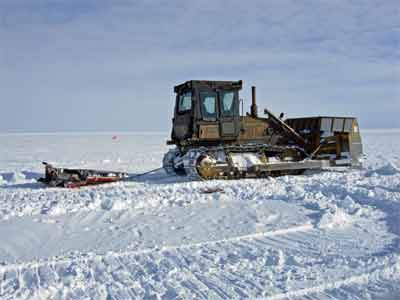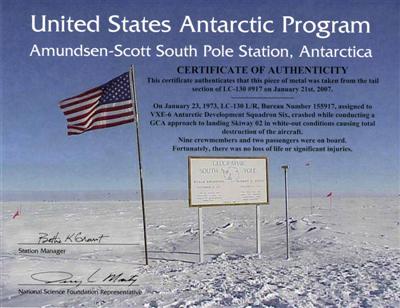That crashed plane at the end of the skiway...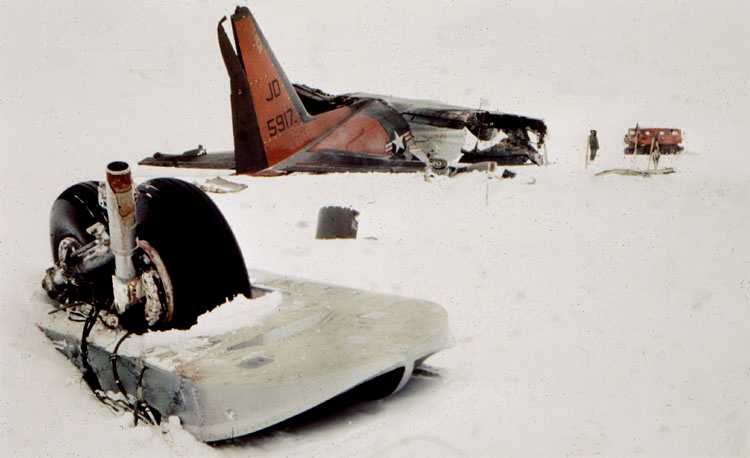  According to the official account, "...the pilot was making a GCA approach in an ice fog at -26°F when the crash occurred. All nine crewmen and two passengers escaped unharmed. Much of the credit for the lack of injuries was attributed to the skill and thoroughness of the loadmaster, ABJ2 David V. Hazzard. He had secured the 20,000 pounds of cargo, mail, and gasoline so securely that the load did not move as the plane crashed and the airframe disintegrated. All of the load was recovered intact with the exception of one 500-gallon bladder of gasoline. The aircraft burned [sic] and was struck from the Navy inventory. This was the third Hercules lost in the past three seasons." (Antarctic Journal, March/April 1973).
According to the official account, "...the pilot was making a GCA approach in an ice fog at -26°F when the crash occurred. All nine crewmen and two passengers escaped unharmed. Much of the credit for the lack of injuries was attributed to the skill and thoroughness of the loadmaster, ABJ2 David V. Hazzard. He had secured the 20,000 pounds of cargo, mail, and gasoline so securely that the load did not move as the plane crashed and the airframe disintegrated. All of the load was recovered intact with the exception of one 500-gallon bladder of gasoline. The aircraft burned [sic] and was struck from the Navy inventory. This was the third Hercules lost in the past three seasons." (Antarctic Journal, March/April 1973).So what are the details? Dave Crouse was one of the pilots of 917 when it made its final arrival at Pole on 28 January 1973. He wasn't at the controls, but here is his amazing tale of the landing as it happened, courtesy of Dave Riley's home page. The above view as well as the one at right were from Ralph Lewis who showed up a day after the crash as the investigation started. Below are a couple more crash pictures from Billy-Ace Baker: | |
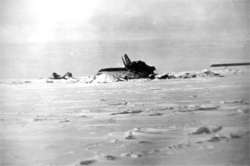 The view at left of the plane wreckage came from the roll of old negatives we found at Old Pole
during the 1977 winter. Based on the other stuff on the film, this picture was
probably taken during the 1974 winter (well, before sunset or after sunrise).
The wreckage had been moved off of the new skiway but was still fairly close
to the new station. In the right background is the end of the fuel arch which
had been completed the previous summer; behind you is the old station.
The view at left of the plane wreckage came from the roll of old negatives we found at Old Pole
during the 1977 winter. Based on the other stuff on the film, this picture was
probably taken during the 1974 winter (well, before sunset or after sunrise).
The wreckage had been moved off of the new skiway but was still fairly close
to the new station. In the right background is the end of the fuel arch which
had been completed the previous summer; behind you is the old station.
For the crash story and the rest of the pictures, see Joe Hawkins' excellent 917 page. 1996 w/o and friend Simon Hart has some more pictures here. Here is his archived home page. Back to the old days...remember that 917 sat in front of the new station ever since the crash...as seen in these two 1973-74 pictures: In early 1975 when the dedication of the domed station was imminent, the decision was made to move 917 away from the festivities. Apparently this was a two-stage effort...the first move was made with the orange D-8 as seen below. Passengers include Jan Boyd (visiting Chalet secretary) forward in the left hand photo, and Randy Baier (summer cook) over the wing (these and the 73-74 photos are from Dick Wolak). A few days before the 9 January 1975 dedication of the domed station, the move and adjustment was completed--917 was moved to its present location as a radar marker about a mile upwind of the McMurdo end of the skiway...by forklift. The fuselage and tail sections were moved separately and aligned as they had been after the crash. The forklift driver you see in the picture at left below is Elena Marty, Jerry's wife. She was the first female contractor (H&N) employee to work at Pole. At right is a look back towards the station past the relocated wreckage. At left below is another view of 917 shortly after the move; the tracks are still visible. At right is a hero shot of Jerry and Elena Marty atop the fuselage (these 4 photos courtesy NSF/Elena Marty). 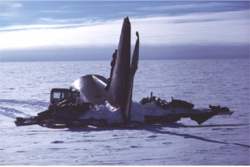  Below, a view from a bit later in January after 321 had been fully "reassembled" and snow had drifted a bit. This photo is from Jim Mathews  And below, here is the official "movement report" written by Phil Carnes and provided by Dick Wolak: 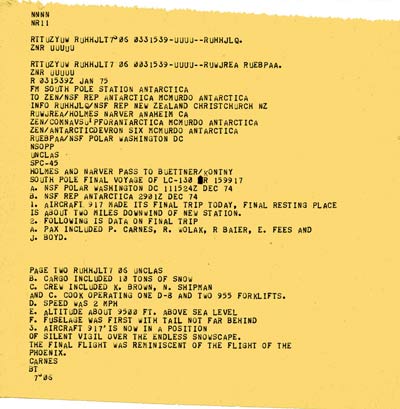 
Here is where we found this wreckage in 1976-77, perhaps 3/4 mile downwind of the 20 end of the skiway where it was moved from the front of the station just before the dedication as described above. The wreckage was lined up with the skiway coordinates to serve as a radar beacon. It is amazing to see 21st century pictures of this airplane which show only a couple of feet of the tail above the snow...soon it would disappear from sight (but not from radar)...nor out of mind. 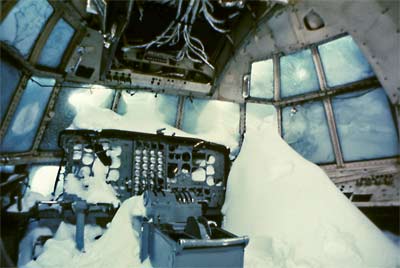
Inside the cockpit. In our days this was not a hazardous confined space, but it WAS COLD! These 917 pictures were copied from Alex Zaitsev... 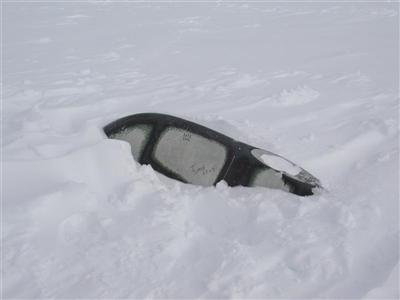 For the record, here's all that was visible above the snow surface in 2002-03 (picture by Robert Schwarz) But that is NOT all. We now have... the next phase...otherwise known as the skiway relocation project... Well, it seems that the story of 917 (scroll up for the beginning) didn't end here. If you've been paying attention, you'll know that in the early 90's the astronomers started putting great big telescopes and other stuff on the west side of the skiway over near Old Pole. This caused lots of traffic, which created two problems. One was the fact that the pilots didn't like folks wandering around on the skiway when they were trying to land (well, I don't blame those pilots, after all I was a culprit myself once in the late 80s). Hence, the crossing beacons, which seriously chilled the folks trying to cross...and the other being the fact that said folks crossing the skiway (particularly with vehicles and equipment) tended to compact the crossing route a bit differently than the rest of the skiway, causing a bit of a bump, which the pilots did not appreciate and tried to avoid. To alleviate these issues, NSF decided to shift the skiway about a mile south so that it no longer would cross in front of the dark sector. BUT...it seems that a certain buried aircraft was still a bit too close to the surface for comfort, so in January 2007 the tail section was dug up and removed, as it were. Photos: | |
Above left, University of Chicago machinist Bob Spotz (on volunteer time) is cutting up scrap pieces to create the hard evidence...pieces of the tail, as it were: | |
|
The actual relocation of the skiway did not occur until the beginning of the 2008-09 summer season. | |

